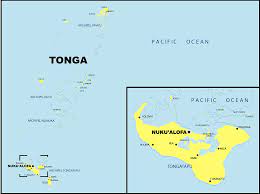18 Jan 2022 Tonga

- Recently a volcanic eruption occurred in the southern Pacific island of Tonga, causing tsunami waves around the Pacific Ocean.
- The Tonga Islands lie in the ‘Ring of Fire’, a periphery of high volcanic and seismic activity that surrounds the Pacific Ocean basin.
Introduction
- It is an under-sea volcanic eruption, consisting of two small uninhabited islands, Hunga-Hapai and Hunga-Tonga.
- Hunga-Tonga-Hunga-Hapai has been witnessing regular volcanic eruptions over the past few decades.
- During the events of 2009 and 2014-15 also there were eruptions with hot jets of magma and steam. But these eruptions were much smaller compared to the recent events (January 2022).
- The eruption of this time is one of the largest eruptions, which are recorded every thousand years.
- One of the reasons for its high explosiveness is the ‘fuel-coolant interaction’.
Effect:
- Huge volcanic eruptions can sometimes cause temporary global cooling as sulfur dioxide is pumped into the stratosphere. But in the case of the Tonga eruption, preliminary satellite measurements indicate that only 0.01 Celsius of the amount of sulfur dioxide will have a small effect on the global average cooling.
- The explosion changed atmospheric pressure, which may have helped clear the fog in Seattle in the United States for some time.
- These waves crossed the Pacific and caused two people to drown in Peru and minor damage in New Zealand and Santa Cruz, California.
- The US Geological Survey estimated that the eruption was the equivalent of a magnitude 5.8 earthquake.
Volcano
- A volcano is an opening or rupture in the Earth’s surface that ejects hot liquid and semi-liquid rocks, volcanic ash and gases in the form of magma.
- Volcanic hotspots are places where Earth’s tectonic plates meet.
- Volcanic eruptions occur when lava and gas erupt from a volcano, sometimes in an explosive form.
Volcanoes under the sea:
- Undersea volcanic eruptions occur in a volcano that lies beneath the surface of the ocean. There are an estimated one million volcanoes within the ocean and most of them are located near tectonic plates.
- Apart from lava, ash also comes out from these holes. These accumulate on the ocean floor and form sea mounds – underwater mountains that build up on the ocean floor but do not reach the surface of the water.
Fuel-coolant interaction
- If the magma rises slowly in the sea water, a thin layer of steam is formed between the magma and the water even at a temperature of about 1200 °C. It provides a layer of insulation to cool the outer surface of the magma. But this process does not work unless magma erupts from a volcanic gas-laden land.
- When magma rapidly enters the water, the vapor layer is soon disrupted, allowing the hot magma to come into direct contact with the cold water.
- It is similar to a chemical explosion.
- Extremely violent eruptions eject magma.
- A chain reaction begins, exposing freshly heated interior surfaces to water, with fragments of new magma eventually ejecting volcanic particles and erupting with supersonic speed.


No Comments